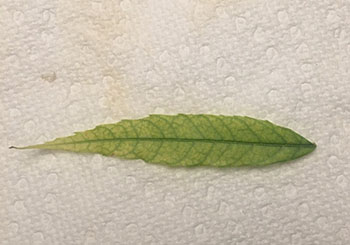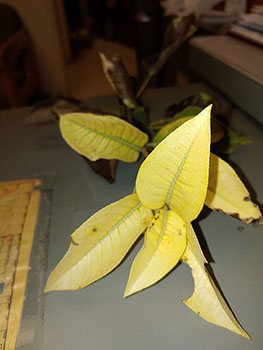June 13, 2020
Bad Combo: Chlorosis and Water Stress
Question:
We have a Raywood ash that’s probably eight years old and huge. The tree has done so well; however, this year I noticed it is more of a light lime green instead of a true green. I am wondering if we need to amend the soil with anything. I did put 10-10-10 in its drip line two months ago, and it gets watered approximately every 10 days.
- M. Hobson, Rio Rancho (submitted via NMSU Extension Agriculture Agent for Sandoval County, Lynda Garvin)
Answer:
This looks like classic chlorosis that’s common in our region due to limited iron availability in our high-alkaline soils. I picnicked in Redlands Park in the Albuquerque West Mesa last week and noticed very similar partial canopy yellowing in those ash trees too. I examined those trees and attributed the partial chlorosis to a stress response from being under-watered in a turf setting and the trees’ visibly girdling roots.

According to NMSU Extension Guide H-171: Iron Chlorosis, “One of the most common landscape plant disorders in New Mexico is iron deficiency, also called iron chlorosis. Iron deficiency symptoms typically begin in spring when the plants are leafing out. As summer progresses, untreated plants typically exhibit severe symptoms and have an overall unhealthy appearance… In most cases, the plants are suffering only from iron deficiency either by itself or combined with other environmental stresses, such as water stress, hot and drying winds, and other nutrient deficiencies.”
I believe in this case you’ve got a combined chlorosis and water stress issue from too little water or watering in the wrong spots. I called my predecessor, Dr. Curtis Smith, to talk through these symptoms and the best ways to address them. Smith remarked that, in addition to nutrient deficiency in this tree, “environmental factors that have to be considered.” He continued, “In New Mexico we rarely ever have just one stress factor.” Visit the blog version of this column for a link to Dr. Smith’s related blog post about monitoring depth of soil moisture in your yard and other resources too, Desert Blooms.
In order to understand if there’s a water stress component, we need to know where the water is applied, if there is a weed barrier under the rocks, and, if so, can water easily pass through it (if it’s a plastic barrier it needs to be pulled up, at least partially). Irrigating every 10 days sounds great, but how long do you water? How many emitters are located out along the canopy drip line and beyond? Also, does soil dry down between irrigations?

Many nutrient deficiencies can be mitigated by improving irrigation practices and soil moisture retention! I’ve seen instances where you have two of the same plant side by side, one with iron chlorosis and one with normal pretty green leaves. In these situations, I suspect root problems in the tree with chlorotic leaves, meaning that the deficiency symptoms in the leaves are caused by water uptake issues more than soil nutrient issues.
Remember, applying fertilizer to a stressed tree can make problems worse very fast. And it may be too late to apply a chelated iron product and see results because most of the leaf growth has already happened.
More from the Guide H-171: Iron Chlorosis, "Applying a chelated iron product should correct the problem. If done in the spring, applying chelated iron to the leaves (foliar applications) is usually effective. In the spring, the iron is readily taken up by the newly developing foliage. Once the foliage is fully developed, iron will not be readily taken up by the leaves. In addition, foliar applications should not be made when the temperature is over 85°F because the chemical will burn the foliage. For treatments later in the growing season, chelated iron should be applied to the soil. High temperatures will also affect the ability of roots to absorb the nutrient; therefore, soil applications during hot weather may be less effective.
“In addition to temperature and leaf development stage, the form of iron chelate should also be considered when iron is applied to the soil. Chelated iron is available in four different forms: FeEDDHA, FeEDTA, FeDTPA, and FeHEDTA2. FeEDTA is the most common iron chelate available. This can be applied to the foliage, but is not effective in New Mexico’s alkaline soils. FeEDDHA is the best iron chelate available for alkaline soils. It can be expensive, and is available online and at most local garden stores. The two other chelated forms—FeDTPA and FeHEDTA—will not be effective in alkaline soils and should be avoided.”

I recommend:
-
Pull mulch back at the base of the trunk and look for the trunk flare (aka root collar—the area where the trunk widens and you start to see larger roots). If the trunk flare is below the soil line, some excavation will be necessary to find and expose the trunk flare. I can’t tell from the photos if your tree is planted too deep, but this is a great time to check and make a correction.
-
Modify Irrigation Practices
a. Where: Irrigate the entire root zone (at the canopy dripline and beyond by several feet).
b. When: Irrigate about once per week through the summer.
c. How much: Irrigate enough to moisten the root zone 2–3 feet deep.
d. Remove any plastic barrier under the rocks, both under the canopy and beyond, so water applied to entire root zone can sink down to 2–3 feet deep.
-
If possible, pull all of the rock out beyond the circled area around the trunk and replace with woodchip or other fibrous, woody mulch 4 inches thick. The little tree will also benefit from this. Consider creating a HUGE mulch ring that includes both trees in a “mulch island” that is big enough that the entire canopy drip line fits inside with a few extra feet for new growth.
-
After doing these things (or at least 1 & 2), watch new growth to see if the leaves green up on their own. I’d love to get an update on this tree a few weeks after changes are made.

See the brand new “Water by the Seasons: Summer Watering Recommendations (June – August) for Greater Albuquerque” infographic created by the Albuquerque Bernalillo County Water Utility Authority to get an idea of how often to water and how deep 505 Outside. These are guidelines designed to help with decision-making. Remember, heavier clay soils take longer to dry out, so confirm that soil has dried down before watering again. Water-logged soils also affect nutrient uptake because oxygen in the root zone is required for water and nutrient uptake.
One final thing, these problems (both with chlorosis and water stress) are very common in New Mexico. In fact, just this week NMSU Extension Agriculture Agents Wayne Cox of Lea County and Troy Thompson of Chaves County also shared photos of trees showing these same signs of severe iron chlorosis on ornamental pear trees.
More on trunk flare/planting:
• Planting Trees: The Hole Story
• Learn to Plant A Tree Video
More on tree roots and irrigation:
• Garden Know-How - link to Part II of this column is embedded in the blog
More info on chlorosis:
• Iron Chlorosis

Marisa Y. Thompson, PhD, is the Extension Horticulture Specialist, in the Department of Extension Plant Sciences at the New Mexico State University Los Lunas Agricultural Science Center, email: desertblooms@nmsu.edu, office: 505-865-7340, ext. 113.
Links:
For more gardening information, visit the NMSU Extension Horticulture page at Desert Blooms and the NMSU Horticulture Publications page.
Send gardening questions to Southwest Yard and Garden - Attn: Dr. Marisa Thompson at desertblooms@nmsu.edu, or at the Desert Blooms Facebook page.
Please copy your County Extension Agent and indicate your county of residence when you submit your question!